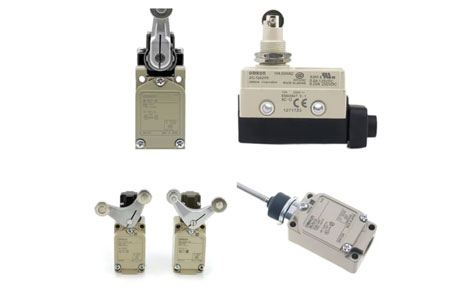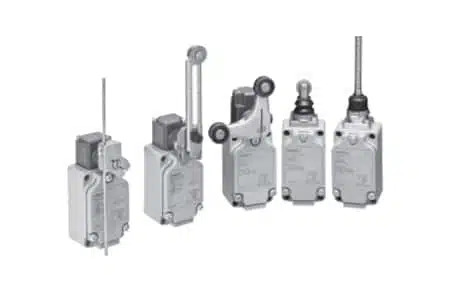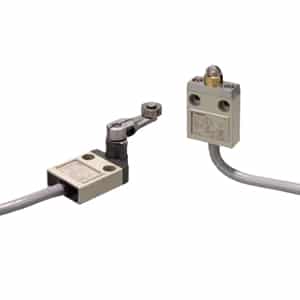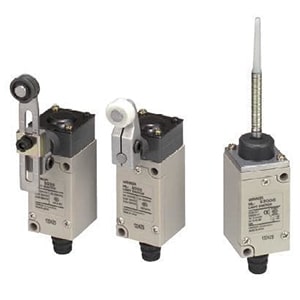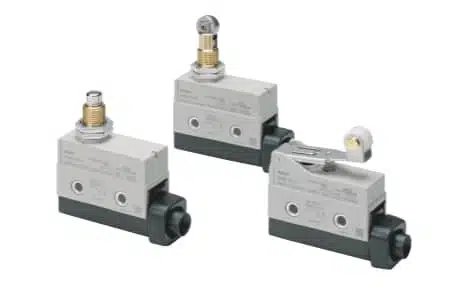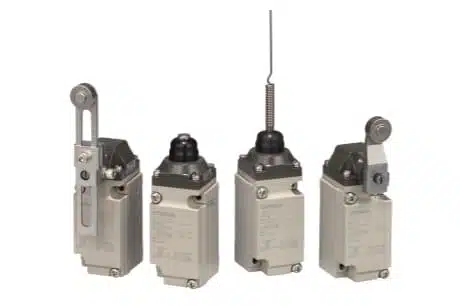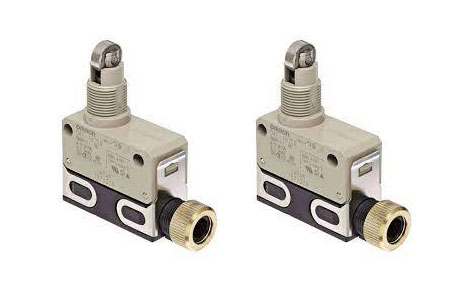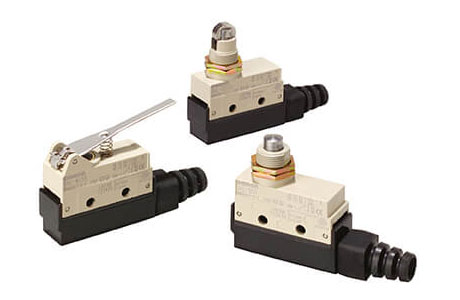Omron Limit Switch: Plunger & Micro Limit Switches in Chennai
IndMALL Automation presents a comprehensive range of Omron Limit Switch, tailored for diverse industrial needs. The WL-N/WL-G Series boasts mechanical durability of 15M operations and electrical longevity of 750K operations, with an operating speed ranging from 1 mm/s to 1 m/s. The Omron D4C Limit Switch, with its compact 16 mm design, offers rugged metal housing and versatile mounting options.
The D4MC Series, suitable for demanding environments, supports a wide range of voltage ratings and ensures high shock and vibration resistance. For more specialized applications, the SHL Series provides compact and robust switches, while the D4E-[]N Series caters to standard and micro load requirements. Each series is designed to offer reliability, efficiency, and adaptability, ensuring optimal performance in various industrial settings.
Our competitive pricing strategy will save you money compared to other Omron limit switch distributors and dealers in Chennai.
Omron Limit Switch: WL-N/WL-G Series
- Durability: Mechanical – 15M operations; Electrical – 750K operations.
- Operating Speed: 1 mm/s to 1 m/s.
- Operating Frequency: Mechanical – 120/min; Electrical – 30/min.
- Insulation Resistance: 100 MΩ min.
- Contact Resistance: 25 mΩ max; Dielectric Strength: Up to 2,200 VAC.
- Vibration Resistance: 10 to 55 Hz, 1.5-mm amplitude.
- Shock Resistance: Up to 1,000 m/s²; Protection: IP67.
Omron D4C Limit Switch
- Size: 16 mm flat, compact design.
- Housing: Rugged metal, triple-sealed for durability.
- Models: Options with M12 connector or oil-resistant cable.
- Voltage and Current: Rated up to 250 VAC and 5 A for AC; 30 VDC and 4 A for DC.
- Durability: Mechanical: 10 million operations; Electrical: 200,000 operations.
- Operating Temperature: -10 to 70°C.
Omron Miniature Limit Switch: D4CC Series
- Compact Size: 16-mm thick with connector.
- Ratings: 1 A at 125 VAC, 1 A at 30 VDC.
- Durability: Mechanical – 10M operations; Electrical – 200K operations.
- Operating Speed: 0.1 mm/s to 1 m/s (varies by model).
- Operating Frequency: Mechanical – 120/min; Electrical – 30/min.
- Insulation Resistance: 100 MΩ min; Dielectric Strength: Up to 1,500 VAC.
- Vibration Resistance: 10 to 55 Hz, 1.5-mm amplitude; Shock Resistance: Up to 1,000 m/s².
Omron Micro Limit Switch: WL Series
- Voltage Ratings: 125/250/500 VAC; 8/14/30/125/250 VDC.
- Load Capacity: Non-inductive up to 10 A, Inductive up to 6 A.
- Operating Speed: 1 mm/s to 1 m/s.
- Operating Frequency: Mechanical – 120/min; Electrical – 30/min.
- Dielectric Strength: Up to 2,200 VAC.
- Shock and Vibration Resistance: High.
- Operating Temperature: -10°C to +80°C.
Omron Limit Switches: D4MC Series
- Voltage Ratings: 125/250/480 VAC; 8/14/30/125/250 VDC.
- Load Capacity: Non-inductive up to 10 A.
- Operating Speed: 0.05 mm/s to 0.5 m/s.
- Operating Frequency: Mechanical – 120/min; Electrical – 20/min.
- Dielectric Strength: Up to 2,000 VAC.
- Shock and Vibration Resistance: High.
- Operating Temperature: -10°C to +80°C.
Omron Limit Switch HL 5000
- Voltage Ratings: 125/250 VAC, 12/24/125/250 VDC.
- Load Capacity: Non-inductive up to 5 A, Inductive up to 3 A.
- Durability: Mechanical – 10M operations; Operating Speed: 5 mm/s to 0.5 m/s.
- Operating Frequency: Mechanical – 120/min; Electrical – 30/min.
- Insulation Resistance: 100 MΩ min; Dielectric Strength: Up to 1,500 VAC.
- Vibration Resistance: 10 to 55 Hz, 1.5-mm amplitude.
- Shock Resistance: Up to 1,000 m/s².
Omron Plunger Limit Switch: ZC Series
- Voltage Ratings: 125/250 VAC, 8/14/30/125/250 VDC.
- Load Capacity: Non-inductive up to 10 A, Inductive up to 3 A.
- Operating Speed: 0.05 mm/s to 0.5 m/s.
- Operating Frequency: Mechanical – 120/min; Electrical – 20/min.
- Insulation Resistance: 100 MΩ min; Dielectric Strength: Up to 2,000 VAC.
- Vibration Resistance: 10 to 55 Hz, 1.5-mm amplitude.
- Shock Resistance: Up to 1,000 m/s².
Omron Switches: D4A-[]NSeries
- Voltage Ratings: 125/250/480/600 VAC; 8/14/30/125/250 VDC.
- Load Capacity: Non-inductive up to 10 A.
- Durability: Mechanical – up to 50M operations; Electrical – up to 1M operations.
- Operating Speed: 1 mm/s to 2 m/s.
- Operating Frequency: Mechanical – 300/min; Electrical – 30/min.
- Dielectric Strength: Up to 2,200 VAC; Shock Resistance: Up to 1,000 m/s².
Limit Switch Omron: D4E-[]N Series
- Voltage Ratings: 125/250 VAC; 8/14/30/125/250 VDC.
- Load Capacity: Standard Load – 5 A; Micro Load – 0.1 A.
- Durability: Mechanical – 10M operations; Electrical – 500K to 5M operations.
- Operating Speed: 0.1 mm/sec to 0.5 m/sec.
- Operating Frequency: Mechanical – 120/min; Electrical – 30/min.
- Dielectric Strength: Up to 1,500 VAC.
- Shock Resistance: Up to 1,000 m/s².
Omron Roller Limit Switch: SHL Series
- Size: Compact, 48 x 17.5 x 45 mm.
- Voltage Ratings: 125/250/480 VAC; 8/14/30/125/250 VDC.
- Load Capacity: Non-inductive up to 10 A.
- Durability: Mechanical – 10M operations; Electrical – 500K operations.
- Operating Speed: 0.1 mm/s to 0.5 m/s; Dielectric Strength: Up to 2,000 VAC.
- Operating Frequency: Mechanical – 120/min; Electrical – 30/min.
- Shock Resistance: Up to 1,000 m/s².
At IndMALL Automation, we specialize in offering Omron limit switch which are crucial for safety and efficiency in industries. We offer a wide range of reliable Omron safety limit switches that ensure machines operate safely. Our Omron safety switches are durable and essential for various automated tasks.
We provide different types for specific industrial needs, including push-button limit switch for precise control in tight spaces and micro limit switches for precise detection. Our mechanical limit switches are long-lasting and perform excellently, helping to maintain high safety standards and smooth operations across various industrial places.
Frequently Asked Questions
What is a limit switch used for?
A limit switch is a device used in machinery to detect the presence or position of an object, triggering a response, such as starting or stopping the machine. It’s typically used in industrial settings to control processes and prevent machinery from moving beyond its intended range.
What does an Omron Limit Switch do?
An Omron limit switch is a device that detects the presence or absence of objects. It activates or deactivates machinery when a set limit is reached. Commonly used in industrial settings, it ensures precision and safety in automated processes. These switches are reliable for controlling machinery operations, enhancing efficiency and safety.
What are the 4 types of switches?
There are various ways to classify switches, depending on the context. Here are four general types of switches based on their operation:
-
Toggle Switches: These are simple on-off switches. When you move the lever, it stays in that position until it is moved again. They are often used in light switches and power tools.
-
Push Button Switches: These switches change their state when you press the button. They come in two types – momentary (returns to its original state once released) and latching (maintains its state until pressed again). They are often used in doorbells, keyboards, and emergency stop buttons.
-
Rotary Switches: Rotary switches are turned like a knob. They have multiple positions and are often used in devices with more than two states, such as a multi-speed fan.
-
Slide Switches: Slide switches are moved from one position to another. They are often used in electronic devices to select operating modes or to turn the device on or off.
Please note that these are general categories, and there are many more specialized types of switches used in various applications, such as dip switches, rocker switches, pressure switches, etc.
What is safe limit switch?
A “safe limit switch,” often referred to as a safety limit switch, is a type of switch used to ensure the safe operation of machinery or equipment. It’s designed to halt the operation of the equipment when it reaches a certain limit, thus preventing accidents, damage, or unsafe conditions.
For example, in a heating system, a safety limit switch might be used to prevent the system from overheating by turning it off if the temperature exceeds a certain limit. Similarly, in an industrial setting, a safety limit switch on a machine might stop the machine from moving beyond its safe range of operation.
These switches play a crucial role in maintaining safety in numerous applications, as they provide an automatic response to potentially unsafe situations. They can be found in many different forms, including temperature limit switches, pressure limit switches, and travel limit switches, to name a few.
How is a limit switch activated?
A limit switch is activated when its actuator (a lever, roller, or some other movable part) comes into physical contact with an object.
In simple terms, here’s how a limit switch works:
-
The limit switch is installed in a place where an object or part of a machine will interact with it at a certain point in its movement.
-
When the object reaches the point where the limit switch is installed, it will physically touch the actuator on the limit switch.
-
The actuator, once touched, triggers the switch mechanism inside, which either opens or closes an electrical circuit.
-
This change in the electrical state is used to control some aspects of the machine’s operation, such as stopping the machine, activating a light, sounding an alarm, or any other action that can be controlled electrically.
What are the disadvantages of a limit switch?
Limit switches, while critical in many applications, also come with some disadvantages:
-
Physical Contact Required: Limit switches need physical contact with the object or part to be detected. This contact may cause wear and tear over time, leading to potential switch failure.
-
Limited Sensing Distance: Unlike some sensors that can detect objects from a distance, limit switches can only sense objects that come into direct contact with them.
-
Slow Response Time: Due to the mechanical nature of their operation, limit switches might have slower response times compared to solid-state or electronic sensors.
-
Prone to Environmental Damage: Limit switches can be prone to damage from extreme temperatures, dust, dirt, moisture, and other environmental conditions. They need to be adequately protected, which can increase the cost.
-
Inadequate for Complex Applications: For more complex control systems or where high precision is needed, limit switches might not offer enough flexibility or accuracy. More sophisticated sensors might be needed for such applications.
-
Installation and Maintenance: Installing and maintaining limit switches can be more challenging and time-consuming compared to electronic or optical sensors.
Despite these drawbacks, limit switches are still extensively used because they are reliable, easy to understand, and cost-effective for many applications.
What is the most common type of limit switch?
The most common type of limit switch is the roller lever actuated limit switch. This type of switch has a lever with a roller at the end, which makes contact with the object and activates the switch.
Roller lever actuated limit switches are used extensively in various industrial applications due to their ease of use and versatility. They can be found in conveyor systems, CNC machines, elevators, and more. When an object comes into contact with the roller, it pushes the lever, which in turn actuates the switch and alters the state of the electrical circuit.
The robustness and simplicity of roller lever limit switches, along with their capacity for reliable, repeatable operation, make them a popular choice for many machinery and equipment manufacturers.
Get the best prices for the Omron Limit Switch.

